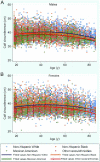Calf circumference: cutoff values from the NHANES 1999-2006
- PMID: 33742191
- PMCID: PMC8433492
- DOI: 10.1093/ajcn/nqab029
Calf circumference: cutoff values from the NHANES 1999-2006
Abstract
Background: Calf circumference (CC) is used in geriatric studies as a simple and practical skeletal muscle (SM) marker for diagnosing low SM and sarcopenia. Currently applied CC cutoff points were developed in samples including older participants; values representative of the full adult lifespan are lacking.
Objectives: We aimed to develop CC cutoff points and to identify relevant confounding factors from the large and diverse NHANES 1999-2006 population sample.
Methods: Demographic, anthropometric, and imaging data (DXA, appendicular lean mass) from the adult (age ≥18 y) NHANES sample were partitioned into subgroups according to sex, age, ethnicity, and race. Adults aged 18-39 y and BMI (in kg/m2) 18.5-24.9 were set as a reference population; CC cutoff points were derived at 1 and 2 SDs below the mean.
Results: The sample included 17,789 participants, 51.3% males and 48.7% females, with respective ages (mean ± SD) of 43.3 ± 16.1 y and 45.5 ± 16.9 y. CC was strongly correlated with appendicular lean mass, r = 0.84 and 0.86 for males and females (both P < 0.001), respectively. Significant differences in mean CC were present across sex, ethnic, self-reported race, and BMI groups. Adjusting CC for adiposity using BMI revealed a decrease in CC beginning after the second decade in males and third decade in females. Rounded CC cutoff values for moderately and severely low CC were 34 cm and 32 cm (males), and 33 cm and 31 cm (females), respectively. Our findings support the use of BMI-adjusted CC values for participants outside the normal-weight BMI range (18-24.9).
Conclusions: This study defined CC values in a diverse population sample along with a BMI-adjustment approach that helps to remove the confounding effects of adiposity and thereby improves CC as a useful clinical estimate of SM mass.
Keywords: anthropometry; body composition; calf circumference; cutoff; malnutrition; muscle mass.
© The Author(s) 2021. Published by Oxford University Press on behalf of the American Society for Nutrition.
Figures





References
-
- Later W, Bosy-Westphal A, Kossel E, Gluer CC, Heller M, Muller MJ. Is the 1975 Reference Man still a suitable reference?. Eur J Clin Nutr. 2010;64:1035–42. - PubMed
-
- Argiles JM, Campos N, Lopez-Pedrosa JM, Rueda R, Rodriguez-Manas L. Skeletal muscle regulates metabolism via interorgan crosstalk: roles in health and disease. J Am Med Dir Assoc. 2016;17:789–96. - PubMed
-
- Deutz NEP, Ashurst I, Ballesteros MD, Bear DE, Cruz-Jentoft AJ, Genton L, Landi F, Laviano A, Norman K, Prado CM. The underappreciated role of low muscle mass in the management of malnutrition. J Am Med Dir Assoc. 2019;20:22–7. - PubMed
-
- Donini LM, Busetto L, Bauer JM, Bischoff S, Boirie Y, Cederholm T, Cruz-Jentoft AJ, Dicker D, Fruhbeck G, Giustina A et al. Critical appraisal of definitions and diagnostic criteria for sarcopenic obesity based on a systematic review. Clin Nutr. 2020;39:2368–88. - PubMed
Publication types
MeSH terms
Grants and funding
LinkOut - more resources
Full Text Sources
Other Literature Sources

